
HPE MSA Storages, Flash-enabled arrays that raise the entry storage bar, making application acceleration possible for a wide range of budgets. Use this guide to learn about HPE MSA considerations and best practices for vCenter.
(See HPE MSA Storages Models List>>>)
What is the Datastore Clusters?
One of the features that simplify the management of storage in vCenter is the datastore cluster. Creating a datastore cluster for the HPE MSA virtual volumes allows for many of the vCenter automations to help balance the storage load. For example, when creating a VM, the initial storage creation will balance between the volumes of the datastore cluster.
Another benefit of the datastore cluster is during the datastore creation, the vCenter software shows only those volumes that are visible to all machines associated with the datastore cluster. This provides a simple way of verifying mappings on the MSA have been configured properly.
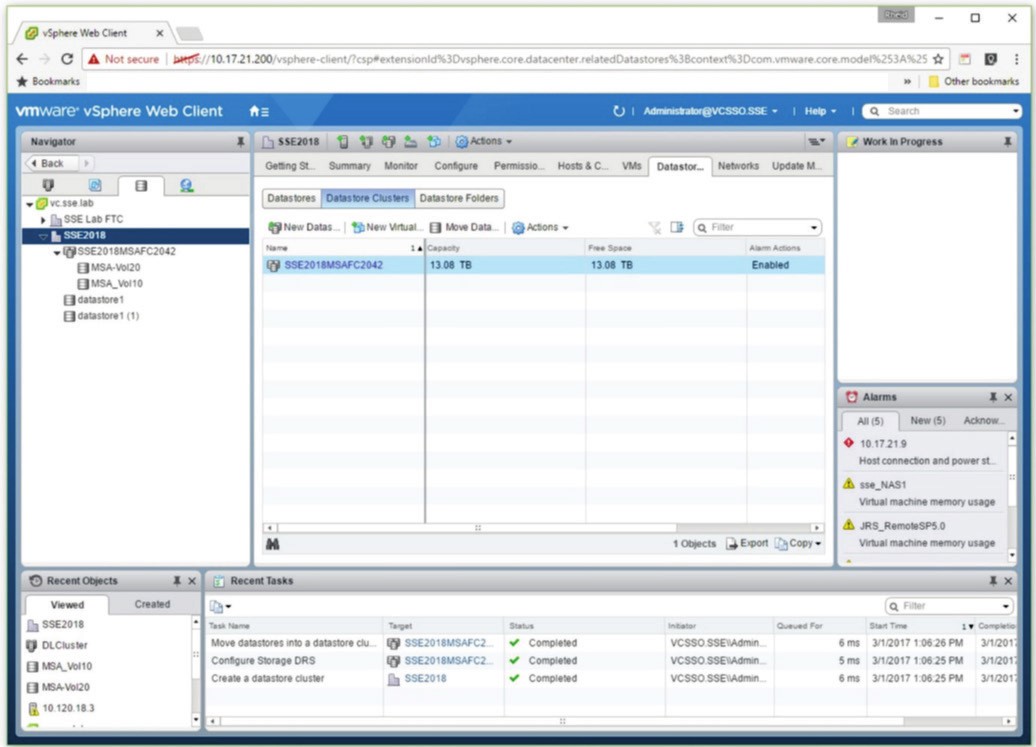
Distributed Resource Scheduler
VMware vCenter Datastore Clusters provide a feature called Storage Distributed Resource Scheduler (SDRS) with I/O load balancing. The intent of this feature is to balance and distribute VM storage needs across traditional physical disk based LUNs.
Because the MSA Storage Array controller and virtual volumes provide the benefits of DRS and I/O balancing dynamically, the VMware’s DRS and I/O load balancing are not needed with virtual volumes as long as all hosts in the cluster share the same MSA volume mappings.
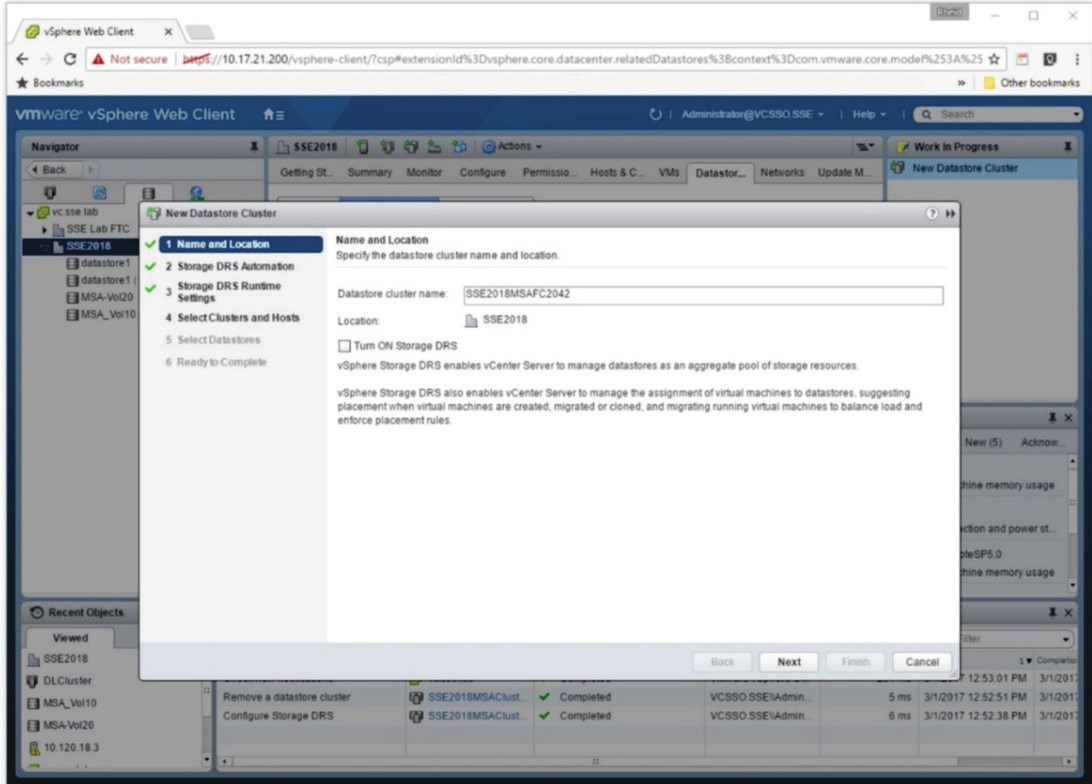
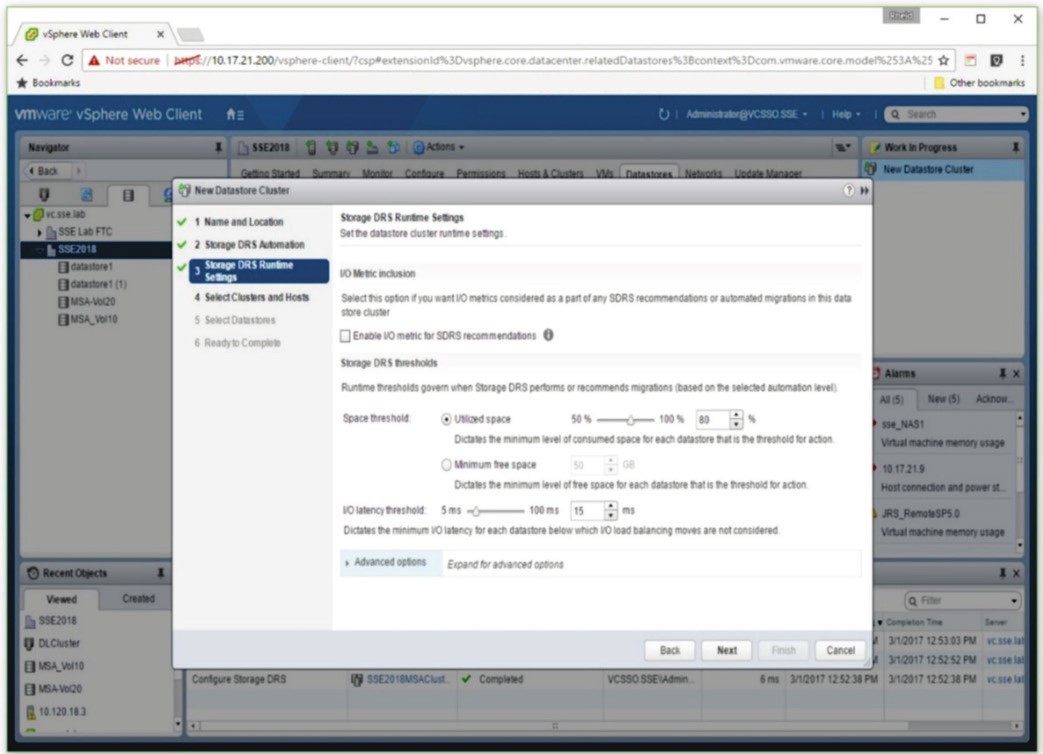
Multipath and Datastore Clusters
The datastore cluster provides a simplified way of managing the multipath configuration for the volumes in the datastore cluster. With the latest version of vCenter, multipath setup and configuration of PSP can be done for any of the ESX hosts from the configuration view for any of the cluster volumes.
Site Recovery Manager and the HPE MSA Storage
Along with the escalating costs of maintaining business-critical applications, for many small to midsize enterprises, the cost of replicating their application servers to recover from disasters can be prohibitive. Implementing a cost-effective data recovery (DR) solution using a VMware-certified SAN infrastructure that supports the failover between vSphere environments and virtual machine instances can be accomplished with the HPE MSA Storage Replication Adapter (SRA) and VMware’s SRM.
A typical SRM configuration involves two geographically separated sites with TCP/IP connectivity between the protected site and the recovery site. The DR protected site is the site that is being replicated to the recovery site. Each site contains an HPE MSA Storage Array, vSphere hosts, a
VMware vCenter Server, and an SRM server.
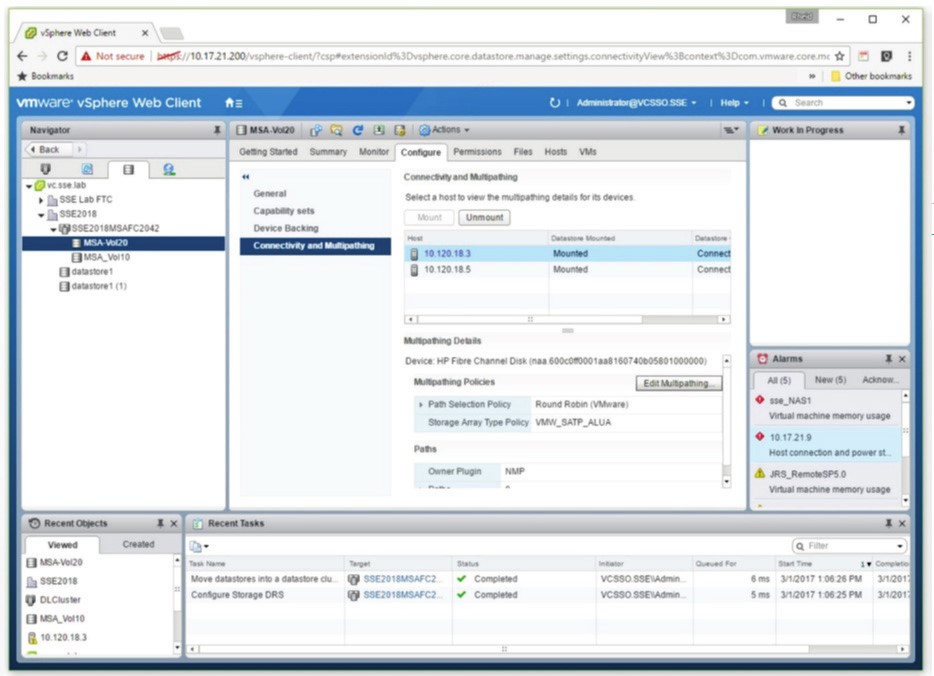
vCenter’s single SRM interface displays and manages all protected recovery sites simplifying administration and the need to personally manage multiple sites separately.
The virtual machines used for DR failover can all reside on a small number of DR servers running VMware vSphere. Although the virtual machine instances may not offer the bandwidth to accommodate peak workloads, the solution avoids downtime. If necessary, use VMware vSphere
Storage vMotion to migrate these virtual machines to more powerful servers as required. The VMware SRM does not replace the functionality of Remote Snap; rather it provides the mechanism for replicating virtual machine data between the protected site and the recovery site.
The HPE MSA SRA provides a platform for a seamless integration of HPE MSA Storage with SRM and aids in the automated DR of virtual machines. It enables SRM to coordinate the recovery process with the underlying replication mechanisms, so the virtual machines at the protected site are shut down properly and the replicated virtual machines can be powered up.
A recovery plan specifies the order in which the protected virtual machines are to be recovered. The recovery plan also specifies network parameters, such as IP addresses, and consists of user-specified scripts that perform custom recovery actions.
After a recovery, the virtual machines that are up and running are no longer protected. To reactivate protection, SRM supports a re-protect operation for virtual machines backed by HPE MSA storage systems. The re-protect operation reverses the roles of the two sites after the
original protected site is back up. The site formerly the recovery site becomes the protected site, and the protected site becomes the recovery site.
SRM also enables recovery plan testing using native functionality without disruption to production environments. This is accomplished by using a temporary copy of the replicated data to conduct tests. After the re-protect operation is used to confirm that the new protected recovery site configuration is valid.
Building an effective disaster-tolerant solution can often be a very complex and time-consuming task. Most disaster-tolerant solutions implemented at customer sites are often untested and fail to protect the application when a failure occurs.
Multi-site Recover Model
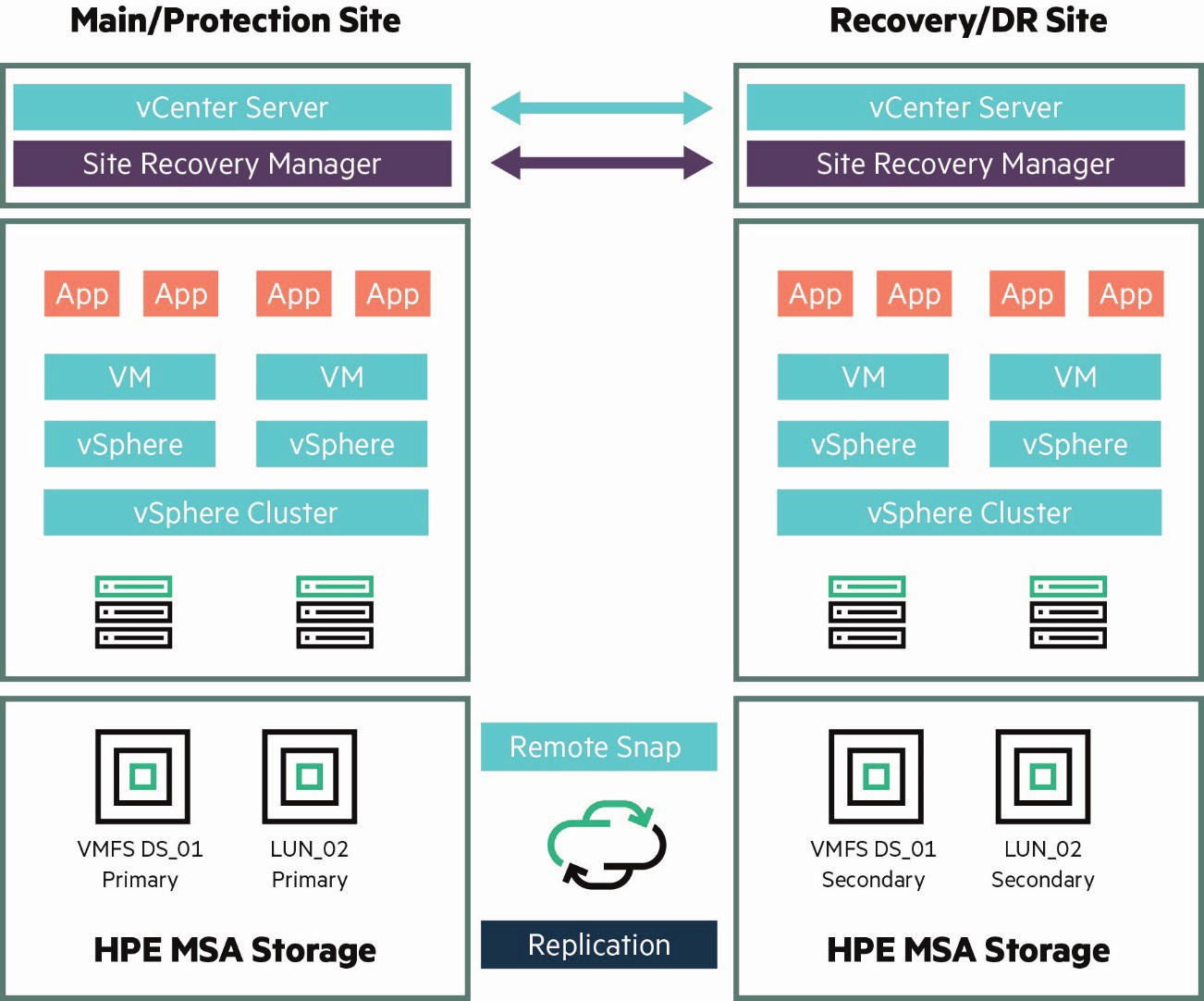
Based on the data center solution or application, the recovery point objective (RPO) and recovery time objective (RTO) may differ from application to application and from customer to customer. Any disaster-tolerant solution must be able to accommodate both planned and unplanned downtime.
Taking full advantage of the encapsulation and isolation of virtual machines, VMware’s Storage Recovery Manager (SRM) can use the HPE MSA SRA to automate a simplified disaster recovery environment. The HPE MSA SRA helps VMware’s SRM meet customer’s DR expectations by simplifying recovery time objectives, reducing the costs of traditional business continuance plans, and achieving low-risk, predictable results for a virtual recovery environment.
When using the HPE MSA SRA with VMware SRM:
- Prepare a plan for re-establishing replication schedules in the event of a site failover. After performing a reverse replication operation, setup replication schedules to ensure periodic replication of data from the new source volumes back to the original source site. Alternately, initiate replication manually, if appropriate.
- Group virtual machines with related backup requirements or schedules on the same datastore volume, because replication occurs on a per-volume basis. For example, if some virtual machines do not need to be replicated to a remote site, or need to be replicated less frequently, do not store them on the same datastore volume as virtual machines which must be replicated frequently, to avoid replicating data unnecessarily.
- Each array must have a unique alphanumeric “System Name” assigned that does not use any non-alphanumeric characters other than “.” Or “-”. No spaces are allowed in the system name.
- Each array must have remote systems defined for each of the remote arrays to or from which data is being replicated. The SRA depends on these remote system names being defined for basic functionality.
- The SRA only supports replication between identical hardware models. For example, replication between an iSCSI-only system and a Combo FC/iSCSI system is not supported.
- Avoid mapping replication volumes to LUN 0. This avoids issues with dynamically mapping and unmapping LUNs, due to special management functionality assigned to LUN 0. Mapping volumes to LUN 0 can be done if those volumes are not expected to be mapped and unmapped automatically the way replication volumes are, such as local datastores that are not replicated.
- Map replication volumes with the same LUN number on all hosts.
- Do not use the same LUN number for different volumes that are mapped to different hosts.
- Failover operations cause read-write host mappings for replication volumes to be converted to read only. Restoring replication converts all read-only mappings for the same volume to read/write. Be careful not to create read-only mappings of replication volumes, for instance, for
data mining purposes. If a read-only mapping of a replication volume is required, consider creating a non-replicated hardware or software snapshot of the volume.
Configuring SRM and the Storage Replication Adapter
Site Recover Manager is an extension of the vCenter Server. When configuring your SRM virtual DR environment that contain HPE MSA Storage arrays, SRM requires a specific Storage Replication Adapter for the HPE MSA. This adapter will need to be installed on both vCenter systems.
Before configuring SRM, ensure the latest SRA software bundle has been downloaded and available by visiting the VMware SRA Download site.
HPE MSA Configuration Requirements
Configuration of the Storage Replication Adapter for the HPE MSA Storage Array requires the setup of two HPE MSA Storage arrays—one at the protected location and one at the remote location.
An important aspect of the configuration of this environment is to ensuring the MSA connectivity to the hosts and vCenter resources are the same for both storage arrays. As a best practice, for production environments use Fibre Channel connectivity to both HPE MSA Storage arrays and the vSphere hosts.
The HPE MSA Storage arrays should also be configured on their own private IP Network for replication communications. This is not a necessity; however, isolating the replication traffic to their own private network will prevent potential network threats and network contention.
(See HPE MSA Storages Models List>>>)
Configure the arrays:
- Configure both HPE MSA Storage arrays to use the same Network Time Protocol (NTP) servers.
- Features of the SRA adapter require both HPE MSA Storage arrays to have licenses for Replication and Snapshots enabled.
- Both MSA’s need to also have the “Missing LUN Response” property set to “Illegal Request.”
- The HPE MSA Storage arrays need to be paired using the MSA’s replication services.
vCenter Configuration Requirements
In order to activate the Site Recovery Manager, download the vCenter extension and install it to both vCenter Servers. The HPE MSA SRA adapter bundle will need to be installed on both vCenter Servers as well.
Configure both vCenter servers where SRM is going to be installed to use the same Network Time Protocol (NTP) servers that the HPE MSA Storage arrays are using.
After both SRM and the HPE MSA SRA are installed, access the “Getting Started” tab of the main SRM window in vCenter.
HPE OneView for VMware vCenter
HPE OneView for VMware vCenter includes a storage management integration plug-in for storage. HPE OneView for VMware vCenter provides the ability to create storage array devices, map them to array ports, and create datastores and virtual machines directly from vCenter.
HPE OneView for VMware vCenter can:
- Provision storage
- Obtain physical and logical end-to-end views of storage devices
- View reports on device capacity and usage
- Monitor storage information
HPE OneView for VMware vCenter saves time and resources, allowing administrators to manage both VMware vSphere and HPE Storage from a common interface.
HPE OneView for VMware vCenter integrates with the vCenter management server and the vSphere Client software from VMware. VMware vCenter is the single point of management for VMware virtual environments. These virtual environments can consist of many standalone or
clustered vSphere configurations. The virtual environment administrator accesses the vCenter management capabilities using the vSphere Client software.
HPE OneView for VMware vCenter software can be installed on a management server or a VM and configured to connect and register with vCenter. After registering OneView for VMware vCenter, all vSphere clients connected to vCenter can use the HPE OneView Software to access
the OneView for VMware vCenter software.
HPE OneView for VMware vCenter provides several ways to access storage information, based on the selected VMware object in the vCenter navigation tree.
Users can select different views of the detailed storage information for the selected object or objects.
- Cluster View: Provides summary and detailed information about the HPE storage deployed in the selected cluster. Summary information describes the used and unused storage available to the cluster, and includes details describing the total amount of storage provisioned by the cluster as virtual disks (VMDKs or RDMs). The storage administrator receives, mapping information for each of the physical HPE Storage arrays that are presenting disks to the selected cluster.
- ESX Server (host) level View: Provides summary and detailed information about the HPE storage deployed to the selected host. Summary information describes the amount of storage available (provisioned) to the host and the amount of storage the host is currently using. Detailed
information includes virtual and physical disks (including virtual to physical mapping), HBA’s, data paths (including virtual to physical mapping, and local and remote copy replication status).
- Virtual Machine View: Provides summary information about the total amount of storage used by the VM and available to the VM. Provides a list of the arrays that provide storage to the selected VM and detailed mapping to the Virtual Disks (physical) Storage Disks, local and remote
copy replication status, data paths and (physical) hosts, and datastores.
- Datastore View: Provides information about the datastores used by a selected VM, or the datastores located on the selected (physical) host.
Summary information includes the provisioned and available capacity within the datastore. Detailed information includes mappings to (physical) storage disks, virtual disks, (physical) hosts, data paths, and replication status (local/remote copy).
HPE OneView for VMware vCenter is available online from this HPE website and can be installed and used at no charge. Acceptance of the standard HPE software licensing terms is part of the download and installation sequence. An HPE Passport sign-in will be required.
Use cases for vSphere and HPE MSA Storage
HPE MSA Storage products with VMware vSphere can accommodate a variety of dynamic business needs and business models.
Mixed Physical and Virtual Computing Environment
Due to operating budget, time, or staffing constraints, many businesses are still virtualizing their core systems. Customer demand for services can also impact migration or upgrade projects. As a result, many businesses have a mixed computing environment, with traditional physical servers sharing workload and storage with virtualized systems. The HPE MSA storage solution supports the storage needs of both physical servers and vSphere hosts. As more systems become virtualized and consolidated, the HPE MSA can grow and scale to suit changing business needs.
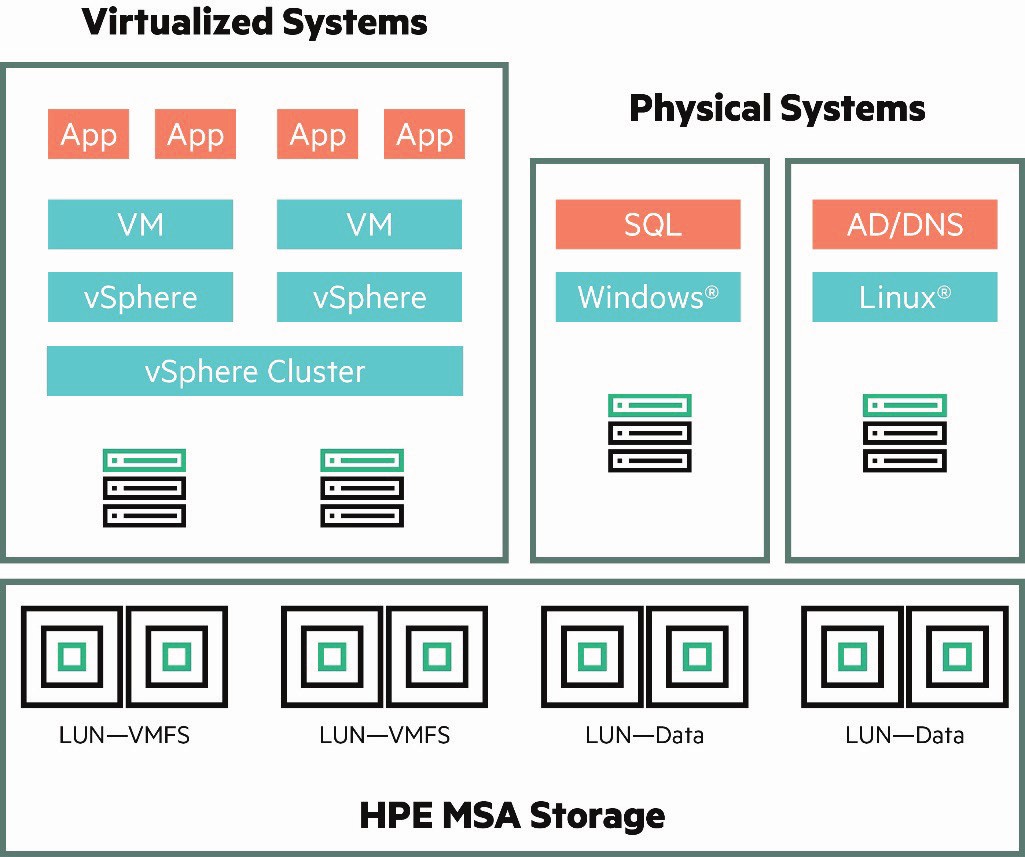
Multiple vSphere clusters on HPE MSA Storage
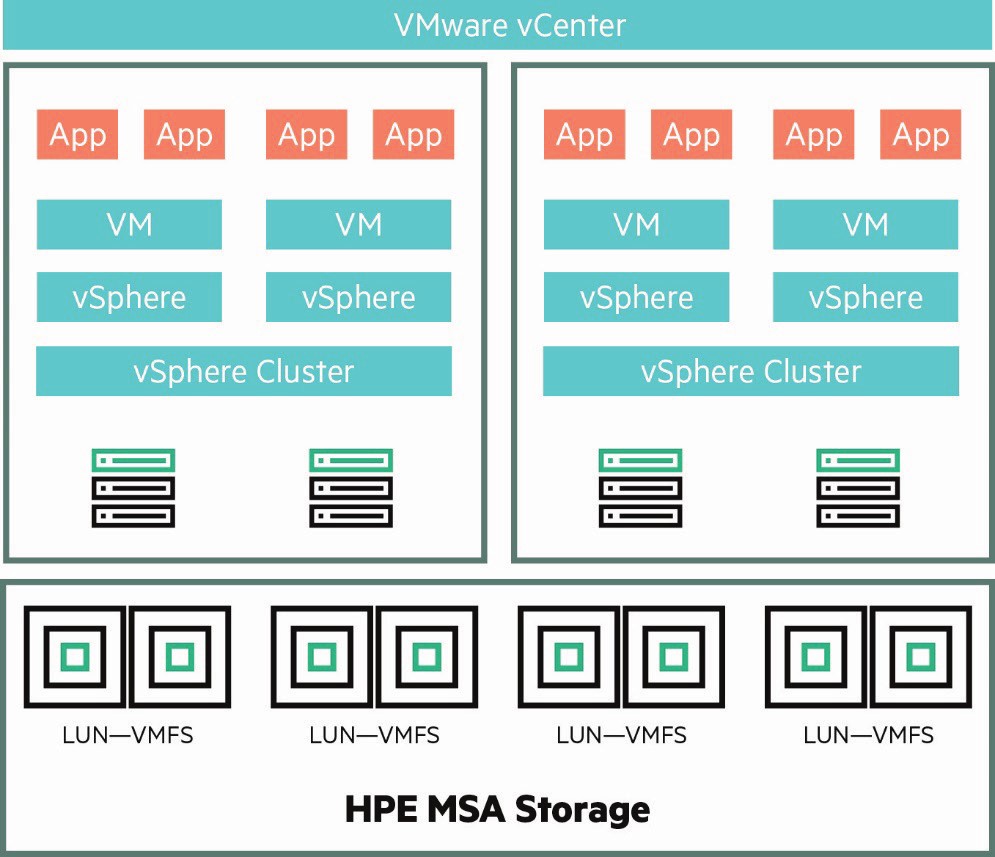
Distributed vSphere Environments
Remote Office/Branch Office (ROBO) deployments offer a decentralized approach for system deployments. Distributed VMware vSphere environments spanning multiple sites can have storage needs which can be cost-prohibitive. With a relatively small physical footprint, entry-level
pricing, the HPE MSA Storage is a practical choice for a storage array solution for a remote office environment. Rapid Provisioning software eliminates array planning by delivering instant, fine-grained, application-tailored storage provisioning. Administrators don’t spend their time
managing storage because the simple and intelligent provisioning automatically adds more storage to support a growing virtual client environment.
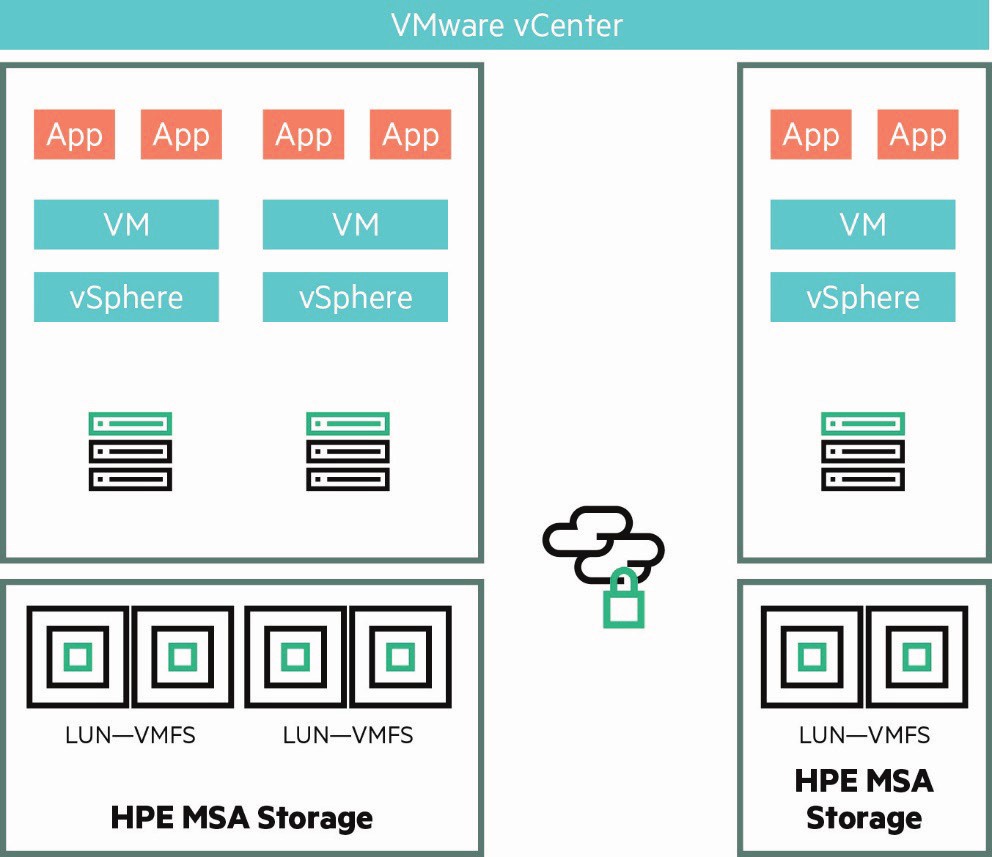
Data Protection with HPE MSA Remote Snap
Cost-effective data protection can be a challenge for today’s small to midsize businesses. The HPE MSA Storage Array and its Remote Snap feature, an affordable, dual storage-array with point-in-time data protection and data replication provides a disaster-tolerant solution. The
array-based, Remote Snap replication feature, implemented with two HPE MSA storage system solutions, provides a business site with ultimate data protection and redundancy.
Remote Snap Software is an optional, licensed disaster-recovery feature that performs asynchronous (batch) replication of block-level data from a volume on a primary HPE MSA, to a secondary volume on the same system or on a separate, independent HPE MSA. These two HPE MSA Storage systems connect through switches and are on the same fabric or network.
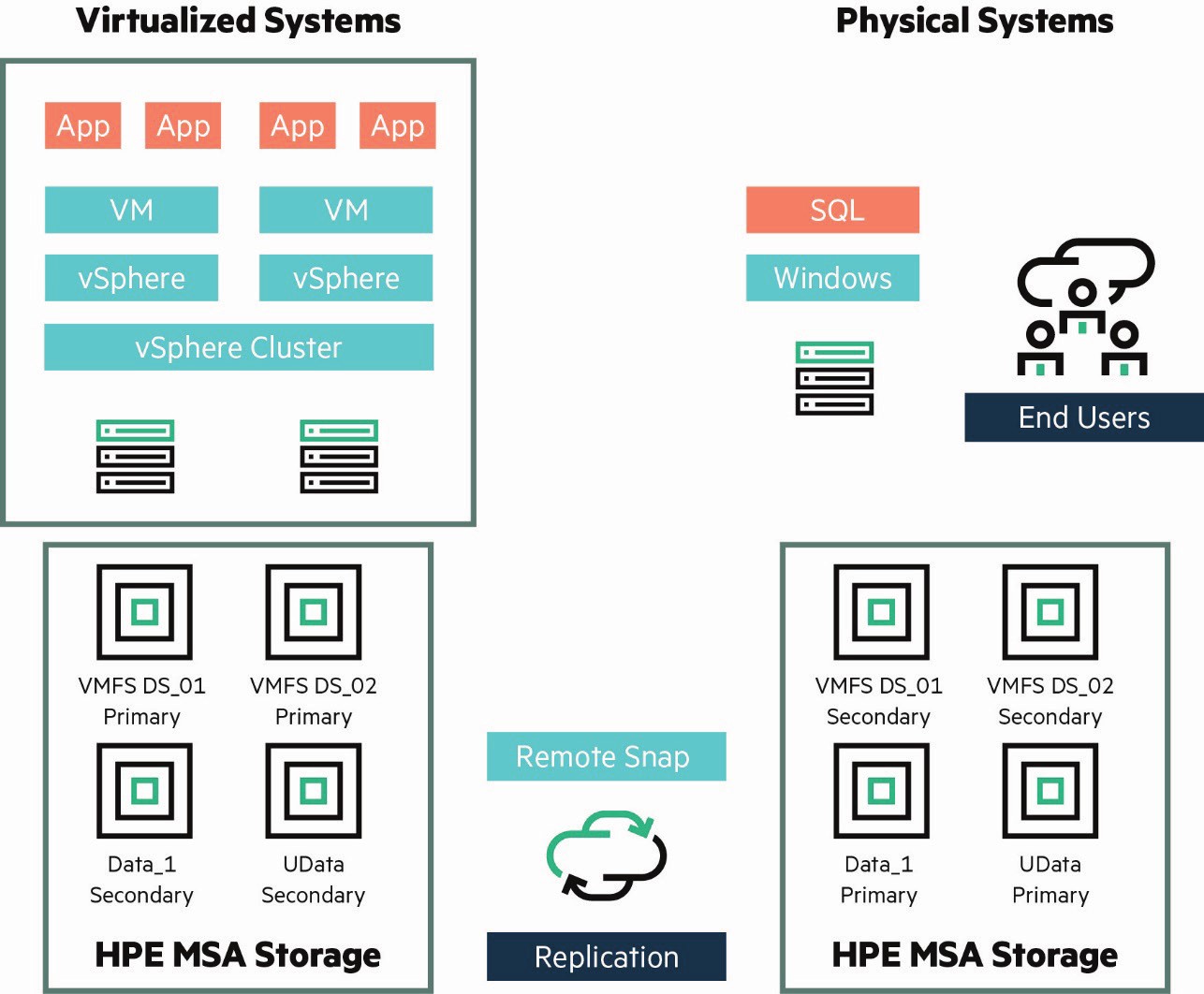
Multi-Site Disaster Recovery
The VMware Site Recovery Manager solution provides virtual data center site disaster recovery. When implemented with HPE MSA Storage arrays for data redundancy, SRM becomes a valuable asset to a business with production demands that require minimal downtime.
VMware vCenter SRM uses the HPE MSA SRA to test DR scenarios and create different recovery plans.
HPE MSA Remote Snapshots must be created on the HPE MSA array before implementing VMware SRM. The HPE MSA SRA uses the Remote Snap feature provided from the HPE MSA. This combination provides the foundation for the SRM solution.
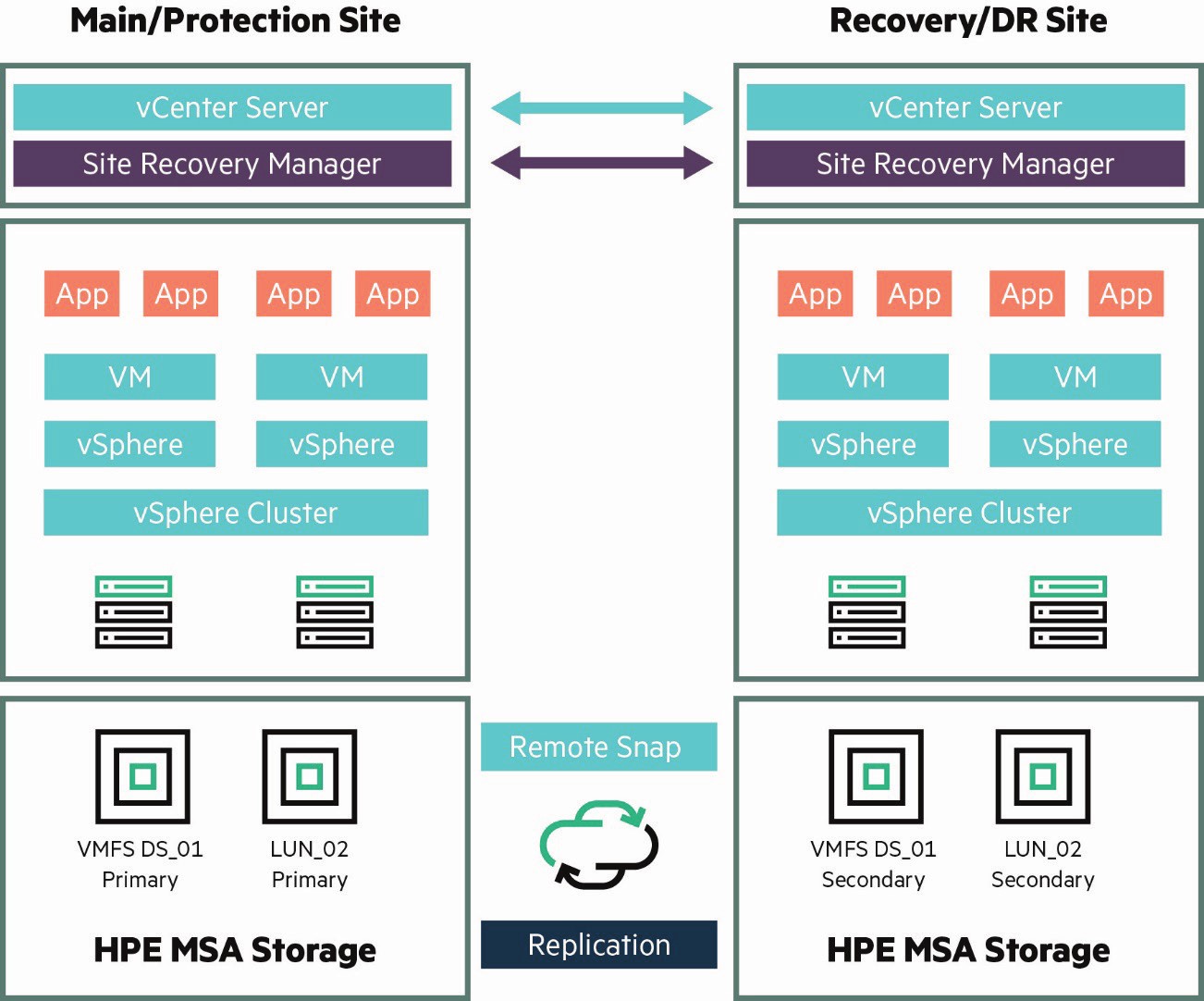
The HPE MSA Storage Replication Adapter requires each Storage Array to have a licensed feature for Replication and Snapshot.
Summary and Benefits
The HPE MSA Storage Array is an exceptional bargain for any businesses. Its rich feature set rivals enterprise storage array offerings making it very attractive as an entry-level storage solution; yet, it has the capacity to scale to meet any business needs of a growing virtualized server environment. The HPE MSA’s Fibre Channel, iSCSI, and SAS connectivity options with Round Robin based Multipath policies makes the HPE MSA Storage Array ready to support test and development environments to full production vSphere solution. The array’s Storage Pool, Disk
Groups, and Virtual Volume ULP complement the VMware features of vCenter and the vSphere environment. All of these features combined with the HPE MSA’s array-based snapshots and replication services create a very versatile storage array for VMware vSphere environments.
When following these best practices and configuration recommendations, the HPE MSA Storage will become an integral part of any IT Solution because it makes storage administration easy.
Additional Information
HPE MSA 1040 Storage Data Sheet
HPE MSA 2040 Storage Data Sheet
HPE MSA 2050 Storage Data Sheet
HPE MSA 2052 Storage Data Sheet
Top-rated HPE DL380, DL360 Servers and MSA Storage
To order HPE MSA storages, you can visit: HPE MSA Storages Models List


